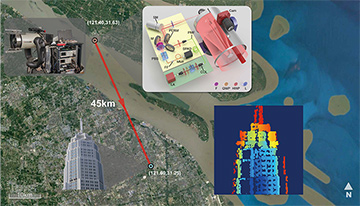 Long-range single-photon imaging across 45 km in Shanghai, China. Left inset: Hardware of imaging system. Center inset: Schematic of system (details in ref. 5). Right inset: Example of long-range single-photon-imaging results. [Enlarge figure]
Long-range single-photon imaging across 45 km in Shanghai, China. Left inset: Hardware of imaging system. Center inset: Schematic of system (details in ref. 5). Right inset: Example of long-range single-photon-imaging results. [Enlarge figure]
Active imaging over long ranges holds considerable interest in a wide range of applications, including remote sensing and target recognition. Single-photon light detection and ranging (lidar) presents single-photon sensitivity and picosecond time resolution,1,2 which are desirable for long-range imaging.
Important progress has been made in this field, and 3D imaging to a range of 10 km has been reported.3,4 Further expanding the imaging range, however, presents enormous challenges, because only weak echo photons return and are mixed with strong noise. This year, we were able to significantly push the imaging range and substantially exceed the previous single-photon-imaging range record.5
In our experiments, we demonstrated single-photon 3D imaging at a range of up to 45 km in urban environments, with a signal level of ~1 photon per pixel. We developed an advanced technique based in both hardware and software implementations specifically designed for long-range single-photon lidar. In hardware, we constructed a high-efficiency, low-noise coaxial scanning system, facilitating the capability both to efficiently collect the weak echo photons and to highly suppress the background noise. In software, we developed a computational algorithm that can achieve super-resolution ability and high photon efficiency in the presence of low photon detections.
Our system represents a significant milestone toward low-power and high-resolution lidar over extra-long ranges. The results may not only lead to new imaging systems for remote sensing and surveillance, but also have important implications for the fundamental problem of the ultimate sensitivity limit in imaging science.
Researchers
Z.-P. Li, X. Huang, Y. Cao, F. Xu and J.-W. Pan, University of Science and Technology of China, Hefei, China
References
1. G. Buller and A. Wallace. IEEE J. Sel. Top. Quantum Electron. 13, 1006 (2007).
2. A. Kirmani et al. Science 343, 58 (2014).
3. A.M. Pawlikowska et al. Opt. Express 25, 11919 (2017).
4. Z.-P. Li, et al. Opt. Express 28, 4076 (2020).
5. Z.-P. Li et al. Photon. Res. 8, 1532 (2020).
